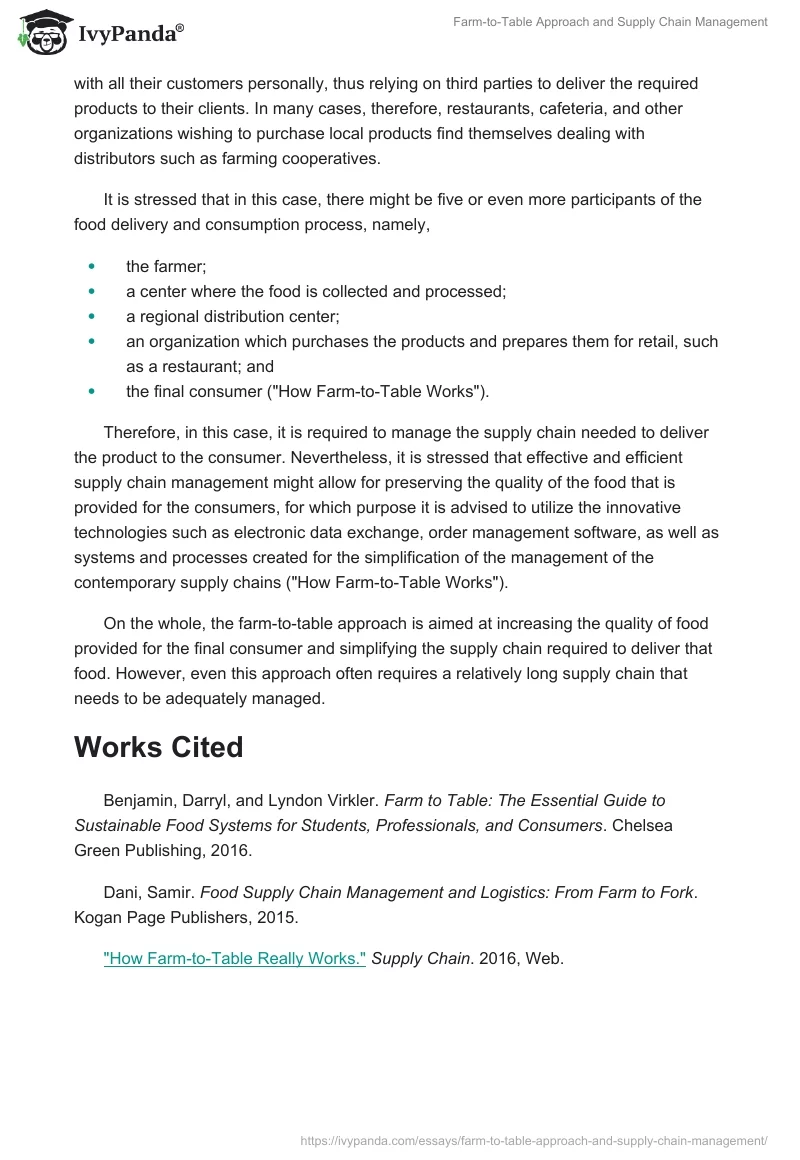Nowadays, due to the increased complexity of the contemporary world, supply chain management has become an essential component of virtually any industry. There exist attempts to simplify supply chains, and the “farm-to-table” approach is one of them. Although this approach may often be successful in simplifying the supply chains, the latter still may include a large number of components even in cases of the relatively low distance between the supplier and the buyer (Dani 2-3).
The term “farm-to-table” is utilized to refer to a conception according to which it is highly desirable that the local food, rather than food which was brought from afar, is provided for consumers in restaurants, cafeterias, local schools, and so on (Benjamin and Virkler 5-8). There are several reasons which the proponents of this conception provide for popularizing the farm-to-table delivery of food; for instance, they may argue that products which were created locally are often fresher, safer, and better for the health than the foods which were brought from afar, because, for instance, the local product may contain a smaller amount of preservatives, or sometimes do not require these at all. Also, it might be argued that the use of local products promotes economic activity in the area by helping the local farms.
Also, when it comes to supply chain management, it should be stressed that the farm-to-table approach to purchasing products for cafeterias, restaurants, and so on ought to allow for a simplified supply chain because the transportation of local food to its consumers should require fewer “links” of a supply chain thanks to the proximity of the food provider. An organization that orders products from a local farm might be capable of contacting the farmers directly and arranging for the delivery of products, without any third parties involved.
On the other hand, ordering products from local farmers is not always possible. For instance, an organization that needs to purchase such products may be located in an urban area, where no farms are present, or in a region where the products that this organization requires are not available. In this case, it becomes needed to order food from more distant farmers. Also, the owners of large farms may often not be able to deal with all their customers personally, thus relying on third parties to deliver the required products to their clients. In many cases, therefore, restaurants, cafeteria, and other organizations wishing to purchase local products find themselves dealing with distributors such as farming cooperatives.
It is stressed that in this case, there might be five or even more participants of the food delivery and consumption process, namely,
- the farmer;
- a center where the food is collected and processed;
- a regional distribution center;
- an organization which purchases the products and prepares them for retail, such as a restaurant; and
- the final consumer (“How Farm-to-Table Works”).
Therefore, in this case, it is required to manage the supply chain needed to deliver the product to the consumer. Nevertheless, it is stressed that effective and efficient supply chain management might allow for preserving the quality of the food that is provided for the consumers, for which purpose it is advised to utilize the innovative technologies such as electronic data exchange, order management software, as well as systems and processes created for the simplification of the management of the contemporary supply chains (“How Farm-to-Table Works”).
On the whole, the farm-to-table approach is aimed at increasing the quality of food provided for the final consumer and simplifying the supply chain required to deliver that food. However, even this approach often requires a relatively long supply chain that needs to be adequately managed.
Works Cited
Benjamin, Darryl, and Lyndon Virkler. Farm to Table: The Essential Guide to Sustainable Food Systems for Students, Professionals, and Consumers. Chelsea Green Publishing, 2016.
Dani, Samir. Food Supply Chain Management and Logistics: From Farm to Fork. Kogan Page Publishers, 2015.
“How Farm-to-Table Really Works.” Supply Chain. 2016. Web.


